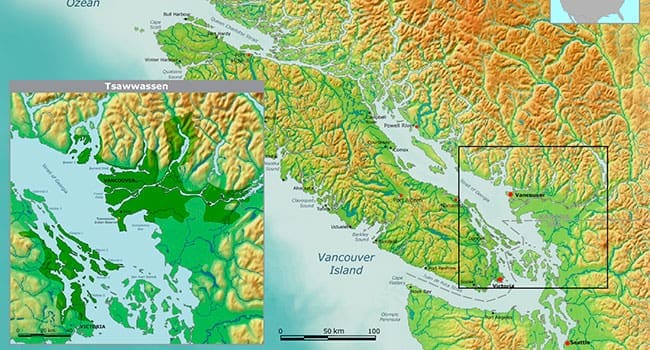By Ravina Bains
and Taylor Jackson
The Fraser Institute
The Tsawwassen First Nation’s proposal to build a liquefied natural gas (LGN) terminal south of Vancouver offers the kind of win-win relationship that could bring prosperity to the First Nation and all of British Columbia.
On Nov. 16, the First Nation announced its interest in building an LNG terminal on Tsawwassen reserve land. The LNG terminal would produce three to five million tonnes of LNG annually and result in five to six monthly LNG tanker visits off the coast of Delta at Roberts Bank.
The next step is to obtain the approval of the 363 members of Tsawwassen First Nation, 170 of whom do not live on the reserve. The initial community vote is scheduled for Dec. 16. If the members support the project, Tsawwassen leadership can move forward with environmental assessments and government permitting. The intention would be to have the facility up and running by 2022.
If approved, the project would offer many benefits. According to the First Nation, they include an unspecified financial benefits package, up to 1,000 jobs during construction and 50 to 100 permanent jobs, education and training programs for Tsawwassen members and community recreational on-reserve infrastructure.
All of these benefits will advance prosperity on the urban reserve. And they could use the help — between 2006 and 2011, the community’s unemployment rate grew from 2.2 percent to 9.7 percent.
Other First Nations communities have successfully built natural resource facilities on reserve land in partnership with industry. For example, Muskowekwan First Nation in Saskatchewan is partnering with Encanto Potash to build the first on-reserve potash facility in Canada; and the Haisla Nation in B.C. has built LNG storage and marine facilities on reserve land.
As well, if this project is approved, it would help achieve B.C. Premier Christy Clark’s LNG goals for the province. With large reserves of natural gas and a geographic advantage, B.C. has the potential to become a major supplier to the growing Asia-Pacific markets. But the process has been slow and delays have become the norm. A Fraser Institute study estimated that the cost of regulatory delay imposed on LNG investments, in terms of lost export revenues, could be $22.5 billion per year in 2020, increasing to $24.8 billion per year in 2025.
Another estimate, from the B.C. government, calculated that if five LNG plants were built, the benefits for British Columbians over a 30-year period could amount to total investment of $175 billion, add $1 trillion to the province’s gross domestic product, and lead to the establishment of 23,800 permanent direct and indirect jobs for operations. These are benefits that all British Columbians will enjoy.
Tsawwassen First Nation says it is “committed to building a better quality of life for its members and the development of a successful and sustainable economy while creating an ideal location to raise a family.” If this on-reserve LNG facility is approved, it will advance the province’s LNG goals while giving the Tsawwassen First Nation education and training programs, opportunities for well-compensated employment, and private-sector supported on-reserve infrastructure projects.
All of this will improve the quality of life for Tsawwassen First Nation members and all British Columbians.
Ravina Bains is associate director for Aboriginal Policy Studies and Taylor Jackson is a policy analyst at the Fraser Institute.
Ravina and Taylor are Troy Media contributors. Why aren’t you?
The views, opinions and positions expressed by columnists and contributors are the author’s alone. They do not inherently or expressly reflect the views, opinions and/or positions of our publication.




